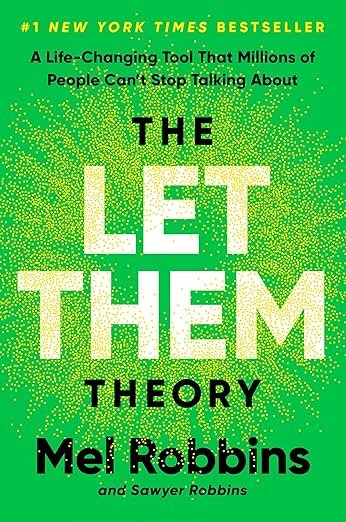If someone wants to leave — let them. If they want to misinterpret your silence as pettiness — let them. If they didn’t invite you, misunderstood you, dumped you, ignored you, or judged you? Let them.
That’s it. That’s the theory.
And Mel Robbins didn’t invent it — but she did something more powerful: she gave it a name.
A viral, instantly memorable, no-nonsense phrase that’s equal parts detachment and empowerment.
In an online world flooded with vague wellness jargon, the Let Them Theory lands with the simplicity of a sledgehammer wrapped in silk.
What Is the Let Them Theory?

The Let Them Theory is about releasing control. Not in a performative “I’m so chill” kind of way, but in a clear, pragmatic “this is not my job” sense.
It’s emotional decluttering — a refusal to manage someone else’s reactions, decisions, or delusions.
According to Robbins, this mindset frees you from the exhausting emotional gymnastics of trying to predict, shape, or fix other people’s behaviour.
Learning the art of letting go might be uncomfortable at first, but it’s often what creates the most peace.
And when she shared it in a casual Instagram post, over 14 million people nodded, shared, stitched, and said: “Oh. That’s what I’ve been trying to do, but couldn’t quite explain.”
Why Did This Go Viral Now?
@abefromanx Detachment and let them theory have always been hard but necessary for me #relationships #breakupadvice #breakuptips #breakups #howtogetoverabreakup #datingtips #relationshiptips #datingtiktok #friendshipbreakup #letthem #letthemtheory #detachment #lawofattraction #lawofdetachment ♬ original sound – Abefroman
Because everyone’s tired.
We’re tired of explaining ourselves to people who don’t listen. We’re tired of performing empathy for folks who weaponise our compassion.
We’re tired of playing referee in group chats, decoding vague texts, or gently confronting red flags with the tone of a hostage negotiator.
The Let Them Theory isn’t about giving up — it’s about opting out of emotional micromanagement.
And here’s the kicker: it’s been echoed for centuries. Buddhism, Stoicism, the Serenity Prayer — all variations of the same ethos.
But Robbins distilled it into a form that’s bite-sized enough for TikTok and deep enough for therapy.
It’s Not Apathetic. It’s Boundaried.
Robbins is careful to draw a line between indifference and emotional maturity.
The Let Them Theory works best when paired with setting boundaries that protect your energy rather than punish others.
Letting them isn’t the same as not caring — it’s caring about yourself more.
That sounds trite until you realise how many hours you’ve lost trying to emotionally babysit grown adults.
Let them ignore your text. Let them choose chaos. Let them think they “won.” And while they’re doing all that? Let you move forward.
The trick, Robbins says, is twofold:
- Say “Let them.”
- Then say, “Let me…”
Let them… be rude.
Let me… keep my peace.
Let them… misunderstand.
Let me… clarify once, then stop chasing.
It’s a shift from reactive to intentional. From “How do I fix this?” to “Is this even mine to fix?”
Why the Let Them Book Resonates So Widely
In her book The Let Them Theory: A Life-Changing Tool That Millions of People Can’t Stop Talking About, Robbins — co-authored with her daughter Sawyer — expands this concept across eight key life domains: relationships, work, goals, social settings, creativity, parenting, boundaries, and emotional regulation.
What makes the Let Them Theory book stand out is its structure. There’s no endless metaphysical musing. It’s peppered with anecdotes, practical scripts, and punchy reframes.
Some key takeaways:
- Stop wasting energy on things you can’t control.
- Stop comparing yourself to others.
- Break free from the fear of being misunderstood.
- Release the grip of others’ expectations.
- Create the love, friendships, and goals that are real — not idealised.
In one story, Robbins recalls a prom night where her son Oakley and his friends had no plan.
She tried to intervene, suggest restaurants, avoid rain — until her daughter whispered, “Let them.”
That reminder didn’t just redirect the night. It rewired her instinct to control what didn’t need fixing.
The Psychology Behind It (That’s Not Instagram-ified)
The Let Them Theory is more than pop advice. It reflects sound psychological practices rooted in:
- Radical acceptance: A Dialectical Behavior Therapy tool that encourages full acceptance of reality to reduce emotional suffering.
- Locus of control: The idea that peace comes from focusing on what you can influence.
- Cognitive diffusion: A mindfulness-based ACT strategy to detach from unhelpful thoughts and regain clarity.
Even Robbins admits she didn’t know how much her own anxiety stemmed from trying to control others until she stopped. “I’m a very smart person,” she says, “but for the first 54 years of my life, I had no idea that controlling everything was draining me.”
What Does the Let Them Theory Mean for Real Life?
Let’s break this down across common stress points:
- Career: Boss took credit for your idea? Let them. Focus on documenting your value.
- Dating: They ghosted after the third date? Let them. You dodged a beige flag.
- Friendship: They forgot your birthday (again)? Let them. And maybe update your trust levels accordingly.
- Family: They still criticise your life choices? Let them. You don’t need their script to write your story.
This doesn’t mean silence. It means strategy. Speak up if needed — but don’t spiral. Let them is a reminder that not every battle deserves your energy.
Just Let Them — and Just Let You
Robbins’ genius lies in her delivery. No jargon. No trauma TikTok vernacular. Just real, relatable detachment that works whether you’re in a boardroom or a breakup.
The simplicity is the product. The mindset shift is the transformation.
So next time someone flakes, judges, interrupts, dismisses, misunderstands, disappoints, betrays, or underdelivers?
Let them.
Then let yourself walk, grow, pause, delete, or change direction.
Because two words might not fix everything. But they’ll stop you from fixing what was never yours to begin with.
And if you’re curious about how Robbins explains this herself, her podcast episode on Let Them is a must-listen — raw, sharp, and full of “oh, that’s me” moments.
You might also like:
- Main Character Syndrome: Understanding the Psychology Behind Feeling Like the Protagonist of Your Own Life
- Why Do People Like Literally Me Characters? Breaking Down the Weird Appeal of Modern Antiheroes
- These Hear Me Out Cartoon Characters Are So Unhinged, But You Know I’m Right
- Thousand-Yard Stare: A Psyche, Meme, and the Internet’s Favourite Cat


